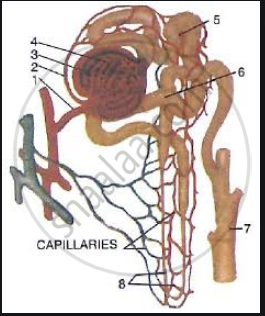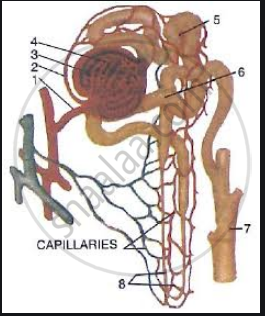Advertisements
Advertisements
प्रश्न
Draw the well-labelled diagram of the human excretory system
Draw excretory system in human beings and label the following organs of excretory system which perform following functions :
1) form urine
2) is a long tube which collects urine from kidney.
3) store urine until it is passed out.
उत्तर

1) Kidneys form urine.
2) The ureter is the long tube which collects the urine from the kidney.
3) The urinary bladder is the structure which stores the urine until it is passed
APPEARS IN
संबंधित प्रश्न
Mention the exact location of the Prostate gland.
The diagram given below shows a section of human kidney. Study the diagram carefully and answer the questions that follow :

(i) Label the parts numbered 1 to 4.
(ii) Why does part ‘2’ have a striped appearance?
(iii) What is the fluid that passes down part ‘4’? Name the main nitrogenous waste present in it.
(iv) Mention the structural and functional units of kidneys.
(v) Name the two major steps in the formation of the fluid mentioned in Q.5 (a) (iii).
The diagram given below shows the male urinogenital system of a human being. Study the diagram and answer the questions that follow:

(i) Label the parts numbered 1 to 8.
(ii) Name the corresponding structure of part (4) in female reproductive system.
(iii) What is the role of part 7?
Correct the following statements by changing the underlined words:
The normal pale yellow colour of the urine is due to the presence of the pigment Melanin.
What gaseous waste products are excreted by plants?
State whether the following statement is true or false:
Some organisms store wastes in body parts.
What is the name of the tubes which connect the kidneys to bladder?
A dialysis machine contains long tubes coiled in a tank containing dialysing solution
What does the dialysing solution contain?
What are the methods used by plants to get rid of their waste products?
In which of the following are the largest amounts of nitrogen excreted from a mammalian body?
(a) breath
(b) sweat
(c) urine
(d) faeces
Write True (T) or False (F) for the following statement. Rewrite the false statement in the correct form.
Excess sugar in the blood is a symptom of diabetes.
Tick the most appropriate answer.
The process of removing waste from the body is called
Given below is a set of five terms. Rewrite the terms in their correct order so as to be in logical sequence.
Afferent arteriole, renal vein, secondary capillary network, glomerulus, efferent arteriole.
Differentiate between the following pairs of term :
Renal pelvis and renal papilla
Define the following term :
Renal pelvis
Explain the difference between the excretory system of humans and plants.
Explain in your own words with suitable examples.
How is excretion in plants useful to human beings?
Choose the correct answer:
The smallest functional unit of the kidney is ____________
Choose the odd one out in the following series:
Proximal convoluted duct, loop of Henle, vein.
Choose the odd one out in the following serie:
Column of Bertini, minora calyces, brain.
The following diagram represents a mammalian kidney tubule (nephron) and its blood supply.

Parts indicated by the guidelines 1to 8 are as follows:
1. Afferent arteriole from renal artery
2. Efferent arteriole
3. Bowman's capsule
4. Glomerulus
5. Proximal convoluted tubule with blood capillaries
6. Distal convoluted tubule with blood capillaries
7. Collecting tubule
8. U-shaped loop of Henle
Study the diagram and answer the question that follow:
Which structure contains the lowest concentration of urea?
The following diagram represents a mammalian kidney tubule (nephron) and its blood supply.

Parts indicated by the guidelines 1to 8 are as follows:
1. Afferent arteriole from renal artery
2. Efferent arteriole
3. Bowman's capsule
4. Glomerulus
5. Proximal convoluted tubule with blood capillaries
6. Distal convoluted tubule with blood capillaries
7. Collecting tubule
8. U-shaped loop of Henle
Study the diagram and answer the question that follow:
Which structure (normally) contains the lowest concentration of glucose?
Differentiate between:
Ureter and Urethra.
The diagram below represents a mammalian kidney tubule (nephron) and its blood supply. Parts indicated by the guidelines 1 to 8 are as follows:
1. U-shaped loop of Henle
2. Proximal convoluted tubule with blood capillaries
3. Bowman’s capsule
4. Afferent arteriole from the renal artery
5. Glomerulus
6. Venule to the renal vein
7. Collecting tubule
8. Distal convoluted tubule with blood capillaries Study the diagram and answer the following questions in each case:
(i) Where does ultrafiltration take place?
(ii) Which structure contains the lowest concentration of urea?
(iii) Which structure contains the highest concentration of urea?
(iv) Which structure contains the lowest concentration of glucose?
(v) Where is the most water reabsorbed?
Explain the Term: Glomerulus
Name the Following
The branch of renal artery which enters into Bowman’s capsule.
Name the Following
The process by which kidneys regulate the water content of the body.
Complete the following sentence with appropriate word:
The knot of blood vessel inside the Bowman’s capsule is ______.
Complete the following sentence with appropriate word:
Besides excretion, the kidneys also carry out the important function of ______.
Write the functional activity of the following structure: Aldosterone
Write the functional activity of the following structure: Henle’s loop
Write the functional activity of the following structure: Renal vein
Choose the Odd One Out:
Choose the correct option.
In human beings, uric acid is formed due to metabolism of ______.
The number of ATP molecules required to produce one molecule of urea from the omithine cycle.
The process of diffusion of solvent particles from the region of less solute concentration to a region of high solute concentration through a semi-permeable membrane is known as ____________.
What is the purpose of making urine in the human body?
The statement given below is false. Rewrite the correct form of the statement by changing the underlined word.
The pigment urochrome is the breakdown product of the haemoglobin of dead RBCs.
Give reason:
Excretion is a necessary process of our body.
